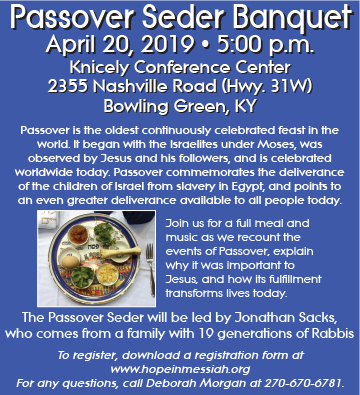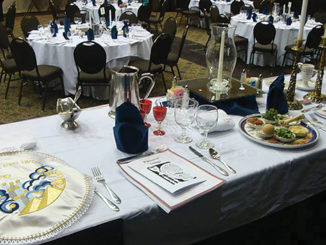
For many people, Passover is not a big deal at all. In fact, many people may not have even heard of Passover. As a Jewish boy growing up in a kosher home in a small town in Michigan, Passover was a big deal – so much so that during the week of Passover, my mother did not let me eat lunch at school. I had only a half hour for lunch. Still she would pick me up at school, drive me home, feed me lunch with foods that were kosher for Passover, and then drive me back to school – all in less than a half hour! And she did the same for my other siblings, even though we were at two or three different schools.
Each year, just before Passover, we removed all of our silverware and replaced it with silverware stored in the attic, which had never been touched by yeast, called leaven. On Passover, we had special dinners, called Seders (pronounced “Say-ders”). At the Passover Seder we tried to identify with the plight of our ancestors in Egypt as we read of their cruel bondage and their ultimate deliverance from slavery in Egypt through Moses. We recounted how the Jewish people were spared the ultimate plague of the death of their firstborn because they placed the blood of the sacrificed Passover Lamb on the doorposts and lintels of their homes.
Years later, after embracing Jesus as my Messiah, I was surprised to learn that Passover was a big deal in the life of Jesus and his disciples. The New Testament records four Passovers during the life of Jesus, one when he was 12 years old, and one in each of his three years of ministry. Jesus’ death, burial and resurrection all took place during the Passover week.
Most importantly, scripture tells us that Jesus died on the day of Passover, at the time of day that the Passover lamb was slain in Jerusalem, the city where the lamb was required to be slain. Jesus fulfilled these and many other requirements for the Passover Lamb. It is no wonder that Jesus is called: “The Lamb of God who takes away the sins of the world.” John 1:29. Jesus is called the Lamb 25 times in the Book of Revelation alone. In 1 Corinthians 5:7, He is called “Our Passover Lamb” who was sacrificed for us.
Passover was a big deal to Jesus, his followers, and the early believers because the Passover lamb pointed to the sacrifice of the Jewish Messiah to redeem his people from the penalty of, and slavery to, sin.
It seems likely that Jesus’ Last Supper appears to have been a Passover Seder. Jesus looked forward to it, saying: “With desire I have desired to eat this Passover with you before I suffer.” Luke 22:15.
We will experience this part of the Seder that has since become what many people call Communion.
During the course of the Seder, we will enjoy special music and a full meal. We’ll have special material for young children, who generally love the Seder and want to come back!
Everyone is invited to participate in and experience a Passover Seder on April 20 at the Knicely Conference Center in Bowling Green. The Seder will include telling the story of Passover from both a traditional Jewish perspective and a Messianic perspective. In this way we will celebrate the deliverance of Israel from slavery in Egypt and the ultimate deliverance to which Passover points – deliverance from sin that only the Messiah can bring.
To register, call Deborah Morgan at 270-670-6781 or download a registration form at www.hopeinmessiah.org. The cost is $30 per adult and $15 per child ages 4-12. Children 3 years old or younger are free. Reservations for a full table of 10 people will receive a 10% discount. The deadline for registration is April 13, 2019.
May you be blessed this year at Passover and always.
– by Jonathan Sacks
About the Author: Jonathan Sacks is the Messianic Pastor of Hope in Messiah Congregation. He comes from a traditional Jewish family with 19 generations of Rabbis. He also practices law in Warren County and surrounding counties.


